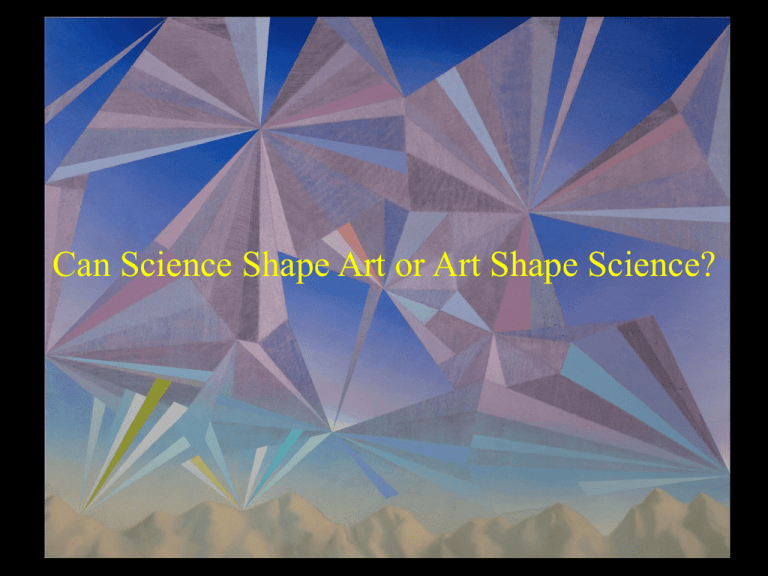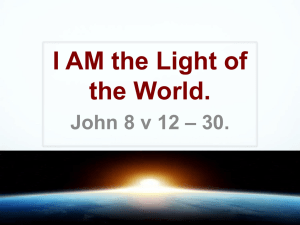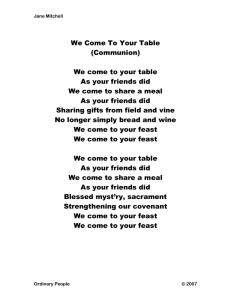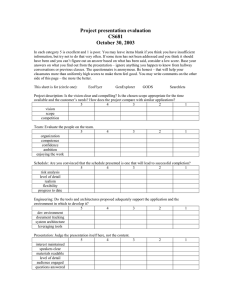Can Science Shape Art or Art Shape Science?
advertisement

Can Science Shape Art or Art Shape Science? The Art and Science of Color An Undergraduate Course for Chemistry and Art Students Chemistry-Inspired Art http://www.geeknaut.com/images/2009/03/periodic_table_keys.jpg http://walyou.com/periodic-table-jewelry/ Imagining the Aesthetic Metaphor Electronegativity Dreams of Valency Lane E. Last, Assistant Professor of Art, University of Tennessee at Martin From “Chemistry in Art, a Virtual Exhibition” http://www.hyle.org/art/cia/index.html The Invention of Painting, Jean Baptiste Regnault http://projectionsystems.wordpress.com/2009/09/06/the-origin-of-painting/ Australian rock painting Hematite: From the Greek, haimatites, "bloodlike'" due to vivid red color of the powder Peche Merle Cave - France Brief History of Pigments in Paintings Impressionist Palette http://en.wikipedia.org/wiki/File:Georges_Seurat__Un_dimanche_apr%C3%A8s- Claude Monet - Early use of cadmium yellow Garden In Bodighera, Impression of Morning Monet 1880 http://upload.wikimedia.org/wikipedia/en/0/0a/Matisse-The-Dessert-Harmony-in-Red-Henri-1908-fast.jpg Webexbits.org and http://webmineral.com/specimens/picshow.php?id=493&target=Hawleyite The Dessert: Harmony in Red, Matisse 1908 Pthalo & Quinacridone Dyes Dyes at Nepalese market Pigment Preparation and History of Art The Feast of the Gods, 15th-16th Century First Version by Bellini http://webexhibits.org/feast/analysis/readingphotos.html Artists’ Styles: Who did it? X-ray photography Branches from top right of Feast of the Gods Titian, The Andrians, c. 1525 Giovanni Bellini, The Infant Bacchus, c. 1505/151 Dosso Dossi, Aeneas and Achates on Libyan Coast, c. 15 National Gallery of Art in Washington, DC http://webexhibits.org/feast/location/vr.html Alfonso d'Este, Duke of Ferrara, (1486-1534) Supposed portrait of Lucrezia Borgia, the daughter of Pope Alexander VI, assumed to be by Dosso Dossi, but very likely her daughter-in-law Renée of France (1535, National Gallery of Victoria, Melbourne, Australia). Alfonso d'Este, Duke of Ferrara, Modena and Reggio, After Titian (attributed to Bastianino), (late 16th or 17th century, Metropolitan Museum of Art). Vasari (1511-1574) reports in Lives of the Artists that Bellini failed to finish The Feast of the Gods before he died and that Titian completed it. Bellini signed the painting and received a final payment of 85 golden ducats from Alfonso on 14 November 1514. Timeline for Feast of the Gods • 1511 Design of studiolo was created by Mario Equicola for Alfonso, who made plans for five paintings • 1514 Feast of the Gods is completed by Bellini • 1516 Bellini dies • 1517 Fra Bartolomeo dies • 1520 Raphael dies • 1518-1529 Titian contributes three of the five paintings needed to fill the studiolo • 1521-1522 The fifth painting is painted by Ferrara's court painter, Dosso Dossi, who also modernizes the Feast of the Gods. • 1529 Titian harmonizes all five paintings Case Study: Inorganic Pigments and History of Art The Feast of the Gods, 15th-16th Century http://webexhibits.org/feast/analysis/readingphotos.html First Version by Bellini Artists’ Styles: Who did it? X-ray photography Branches from top right of Feast of the Gods Titian, The Andrians, c. 1525 Giovanni Bellini, The Infant Bacchus, c. 1505/151 Dosso Dossi, Aeneas and Achates on Libyan Coast, c. 152 1514 1519 1520-1522 1525 1529 Science Laboratory Safety issues specific to work with mineral pigments Light composition; spectrophotometry Color theory; colorimetry Synthesis of Prussian Blue, Chrome Yellow and Green, Bismuth Yellow Final Projects Bridging Chemistry and Art Corroding and Corroded, chemistry on copper Creation 15, 24" x 36", 2002 Creation 17, 24" x 36", 2002 http://www.hyle.org/art/cia/files/index.htm Corroding, 2007 http://www.safren.com/series/chemistryoncopper/ 3.10 eV 2.92 eV Conduction Band 2.64 eV 2.53 eV 2.25 eV 2.07 eV 1.97 eV 1.86 eV 1.77 eV Valence Band Streetman, Ben G.; Sanjay Banerjee (2000). Solid State electronic Devices (5th ed.).Prentice Hall. p. 524. http://gemologyproject.com/wiki/index.php?title=Causes_of_color www.windows2universe.org/sun/spectrum/multispectral_sun_overview.html Decomposition or Composition of Light 700 400 600 470 550 500 Circus Sideshow The “Inorganic Chemistry” Origin of Color Chrome yellow Pb(NO3)2 + Na2CrO4 → PbCrO4 + 2NaNO3 Prussian blue 3FeSO4 + 2K3Fe(CN)6 → Fe3[Fe(CN)6]2 + 3K2SO4 Chrome green 3 Na2Cr2O7 + ½ S8 → 3 Cr2O3 + Na2SO4 + 2 Na2O + 3 SO2 Bismuth yellow NaVO3 + Bi(NO3)3 + H2O → BiVO4 + NaNO3 + 2HNO3



